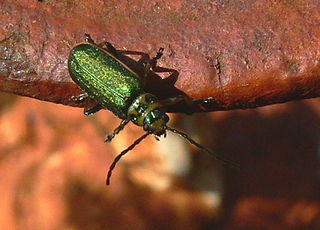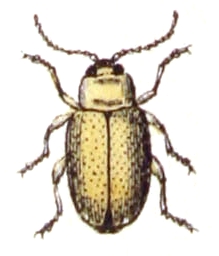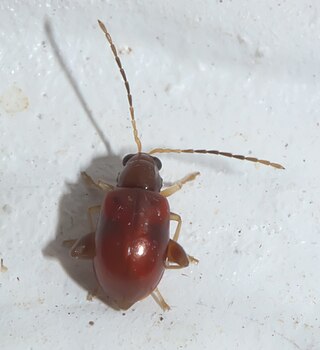
The flea beetle is a small, jumping beetle of the leaf beetle family (Chrysomelidae), that makes up the tribe Alticini which is part of the subfamily Galerucinae. Historically the flea beetles were classified as their own subfamily.

The Eumolpinae are a subfamily of the leaf beetles, or Chrysomelidae. It is one of the largest subfamilies of leaf beetles, including more than 500 genera and 7000 species. They are oval, and convex in form, and measure up to 10 mm in size. Typical coloration for this subfamily of beetles ranges from bright yellow to dark red. Many species are iridescent or brilliantly metallic blue or green in appearance.

The Galerucinae are a large subfamily of the leaf beetles (Chrysomelidae), containing about 15,000 species in more than 1000 genera, of which about 500 genera and about 8000 species make up the flea beetle tribe Alticini.

Cassida is a large Old World genus of tortoise beetles in the subfamily Cassidinae. The natural history of Cassida sphaerula in South Africa is a typical life cycle. Several species of Cassida are important agricultural pests, in particular C. vittata and C. nebulosa on sugar beet and spinach. The thistle tortoise beetle has been used as a biological control agent against Canada thistle.
Anthony Adrian Allen was a British entomologist who published several hundred scientific papers, in particular on the Coleoptera (beetles) of the British Isles. He was active for much of the middle and late 20th century. He formed a bridge between the great entomologists of last century, and the present generation, many of whom benefitted from his knowledge and guidance.
Longitarsus linnaei is a species of beetle of the Chrysomelidae family and the subfamily Galerucinae. It is distributed in the southern part of France, southern Central Europe, Italy and the Balkan Peninsula, the Caucasus, Asia Minor, Israel, Palestine, north-eastern Algeria and Tunisia.
Longitarsus suturellus is a species of beetle in the subfamily Galerucinae. It is distributed in the Palearctic realm from the Pyrenees to Japan. Adult beetles and larvae feed on the leaves of sage (Senecio) (Asteraceae).
Longitarsus melanurus is a species of flea beetle in the family Chrysomelidae. It is found in North America.
Longitarsus pellucidus is a species of flea beetle in the family Chrysomelidae. It is found in Europe and Northern Asia and North America.
Longitarsus rubiginosus is a species of flea beetle in the family Chrysomelidae. It is found in Europe and Northern Asia and North America.
Longitarsus arenaceus is a species of flea beetle in the family Chrysomelidae. It is found in North America.
Longitarsus turbatus is a species of flea beetle in the family Chrysomelidae. It is found in North America.
Longitarsus suspectus is a species of flea beetle in the family Chrysomelidae. It is found in North America.
Longitarsus testaceus is a species of flea beetle in the family Chrysomelidae. It is found in North America.
Longitarsus subrufus, the marbleseed flea beetle, is a species of flea beetle in the family Chrysomelidae. It is found in North America.
Longitarsus erro is a species of flea beetle in the family Chrysomelidae. L. erro is found in North America, specifically Canada.

Longitarsus pratensis is a species of flea beetle in the family Chrysomelidae. It is found in Europe and Northern Asia and North America.

Longitarsus varicornis is a species of flea beetle in the family Chrysomelidae. It is found in the Caribbean Sea, Central America, North America, and South America.
Longitarsus succineus is a species of flea beetle in the family Chrysomelidae. It is found in North America and Europe.

Bromiini is a tribe of leaf beetles in the subfamily Eumolpinae. The tribe contains approximately 120 genera, which are found worldwide. They are generally thought to be an artificial group, often with a subcylindrical prothorax without lateral ridges and covered with setae or scales.







